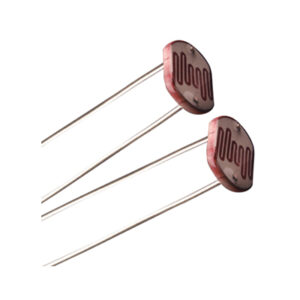A current Limiting or voltage dropping resistor with an LED is very much important, as the behavior of LED behaves very differently to a resistor in the circuit. The series resistor value Rs is calculated by simply using Ohm´s Law V = IR. Current and Voltage is directly proportional given that the resistance remains constant. LED behaves as a diode with a V-I characteristic that is different than a resistor.
Different color LED’s require different forward voltages to operate, red LED’s take the least, and as the color moves up the color spectrum toward blue, the voltage requirement increases. Typically, a red LED requires about 2 volts, while blue LED’s require around 4 volts. Typical LED’s, however, require 20 to 30 mA of current, regardless of their voltage requirements.
The figure below shows a series resistor Rs connected to the LED. As the voltage Vs rises from 0v, nothing happens until the voltage reaches about 1.7v (Red LED), at this voltage a red LED just starts to glow. As the voltage increases, the voltage across the LED remains at 1.7v but the current through the LED increases and it gets brighter.
We now turn our attention to the current though the LED. As the current increases to 5mA,10mA,15mA, 20mA the brightness will increase and at 25mA, it will be a maximum. Increasing the supply voltage will simply change the color of the LED slightly but the crystal inside the LED will start to overheat and this will reduce the life considerably.
Using the above circuit you need to know three values in order to determine series resistance value by the following equation.
If = LED forward current in Amps.
Vf = LED forward voltage drop in Volts
Vs = supply voltage
This shows the importance of using an external series current limiting resistor, which is, a LED must be supplied with a voltage that is higher than its characteristic voltage via a resistor called a VOLTAGE DROPPING RESISTOR or CURRENT LIMITING RESISTOR so the LED will operate correctly and provide at least 10,000 to 50,000 hours of illumination.
Example: To power an LED, assume you have a 12V battery & a red LED and it might have a forward voltage around 1.8V. If you want to limit the current to 20mA, use a series resistor of about 510Ω.
Rs = (Vs-Vf)/If.
Rs = (12-1.8)/0.02. = 510 Ω.
We now turn our attention to the power rating of the Resistor. You need to be sure the wattage (power) rating for your resistor is sufficient for the power being used.
The equation for power is:
P = I * V.
Where:
P=power in watts
I= Total forward current.
V = Total voltage.
Example: assume you are using the LED above with a supply voltage of 12V, an LED forward voltage of 3.8V, and a total forward current of 1500mA.
So, the power rating you should choose for your resistor is calculated by following calculations,
The resistor & LED both has a voltage drops. So, according to Kirchoff’s Voltage Law.
12v – (voltage drop across LED) – (voltage drop across Resistor)=0
12v – 3.8v – (voltage drop across Resistor) = 0
Voltage drop of the resistor, you get is 8.2V.
Therefore p= 1500m * 8.2 = 12.3 watts
Typically, you should get a resistor wattage rating close to twice the calculated value. So a resistor in the neighborhood of 20-25 Watts would be sufficient.
For queries: info@tenettech.com
Contact: 080-26722726









